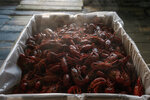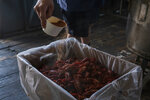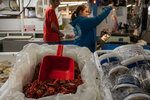Easter dinner across the country often involves a honey-baked ham, but on the Gulf Coast, a popular way to celebrate is with a crawfish boil. This year, be prepared for higher prices and lower …
This item is available in full to subscribers.
Please log in to continue |












Easter dinner across the country often involves a honey-baked ham, but on the Gulf Coast, a popular way to celebrate is with a crawfish boil. This year, be prepared for higher prices and lower supply.
The dry summer of 2023 and uncharacteristically frigid winter took their toll on the crawfish industry, and experts like Mark Shirley, crawfish aquaculture and coastal resources specialist at the LSU AgCenter and Louisiana Sea Grant, expressed concern for the 2024 crawfish outlook. In January, Shirley penned an open letter on his thoughts and observations. In part, the open letter read:
“The drought and heat during the summer and fall caused very high mortality of the carryover crawfish and broodstock. Those are the crawfish that the farmers should be catching in December, January and February. I don’t see the catch picking anytime soon, especially considering the freezing temperatures expected through January. Some farmers still have not put out traps mainly because test traps show no sign of crawfish.”
Shirley also explained the higher prices crawfish customers would see this season.
“In addition to the extremely short supply of crawfish, farmers are also seeing their production costs significantly increase. Pumping costs for flooding and maintaining a flood have tripled and, in some cases, quadrupled. Combined with the rise in labor cost, bait and supplies, this will be a very expensive crop to produce.
“Even with record high prices, I’m afraid many farmers will not cover their production costs of pumping, labor, bait, fuel and indirect costs for this season.”
Now we are at the end of March, and while prices have fallen slightly and the supply has improved, the industry is still hurting.
Billy’s Seafood in Bon Secour has seen the supply and pricing fluctuations firsthand. Owner Billy Parks said they began receiving crawfish toward the end of February. He was selling cooked crawfish for around $12.99 a pound. Now the prices have fallen to $6.69 a pound cooked. This time last year, a pound of cooked crawfish cost $3.99.
Not only is the price higher than in years past but the supply is low. In March 2023, Parks said, they sold around 500 sacks of crawfish. This year, he’s at 86. His crawfish supplier does its best to fill his order, but sometimes he gets shorted.
“I could have got a few more, but it’s just the sales are so slow because of the price," he said.
For Easter weekend in 2023, Parks said they sold a little over 100 sacks. This year, he is projecting to sell between 40 to 50.
March and April are the peak of crawfish season with ponds producing the biggest volumes.
“We’re somewhere between 20% to 25% of a normal harvest as of today,” Shirley said. “I don’t expect this to get better. In fact, I’ll make the catch will probably drop in April and May. There’s just not a lot of crawfish in the ponds to keep the harvest going to this level.”
According to Shirley’s expert opinion, we have seen the peak of crawfish production for this season. Over the last 40 years, he said the biggest volume of crawfish available to the market comes in March, April and May.
This season has been devastating to crawfish farmers who farm approximately 374,000 acres, but Shirley pointed out it is more than just the farmers who are negatively affected by this year’s harvest.
“We have a whole industry that is based on the supply of crawfish that farmers produce," he said. "You have thousands of trucks that haul crawfish to Houston, Texas and Memphis, Tennessee. We have processing plants that peel crawfish. Some of these plants have over 100 people working to peel and package crawfish tail meat and deliver that to grocery stores and restaurants.”
With the prices so high for whole crawfish, Shirley said the meat processing isn’t happening.
“They just can’t afford this higher price because if they peel that crawfish and put it into the grocery store, you might be looking at $25 to $30 a pound for crawfish tails,” he said.
While the overall economic impact won’t be known for months, Shirley said he estimates to just the crawfish farms it will be around $140 million but could be more than $200 million in the end. He said he would have a better idea in May.
The lasting impacts of this one bad season could be seen for years on the farmers, restaurants, processing plants and more.
“We may see some farmers go out of business and have to sell their land and change their lifestyle. That’s how serious this is,” Shirley emphasized. “You look at a very broad range of impact, not just our farmers, but it’s going to be an economic and basically a cultural impact as far as crawfish usually travel.”
When asked about the rebound of the industry, Shirley said it could be years. A bad harvest can mean it may be harder for a farmer to get a bank loan to put in their rice crop and get their stock crawfish. Some farmers who typically stock their ponds with their own crawfish may not have any.
While the outlook seems bleak, there are still mudbugs available to enjoy while they last. Billy’s Seafood takes delivery every Tuesday, Thursday and Saturday, and Parks said those wishing to get sacks or multiple sacks of live crawfish can call ahead and put in an order, and he will do his best to fill it. But do it sooner because he doesn’t expect the season to last until June like in years past.
Parks has 49 years of experience in the business to compare to.
“No," he said, "I have never seen it like this ever."